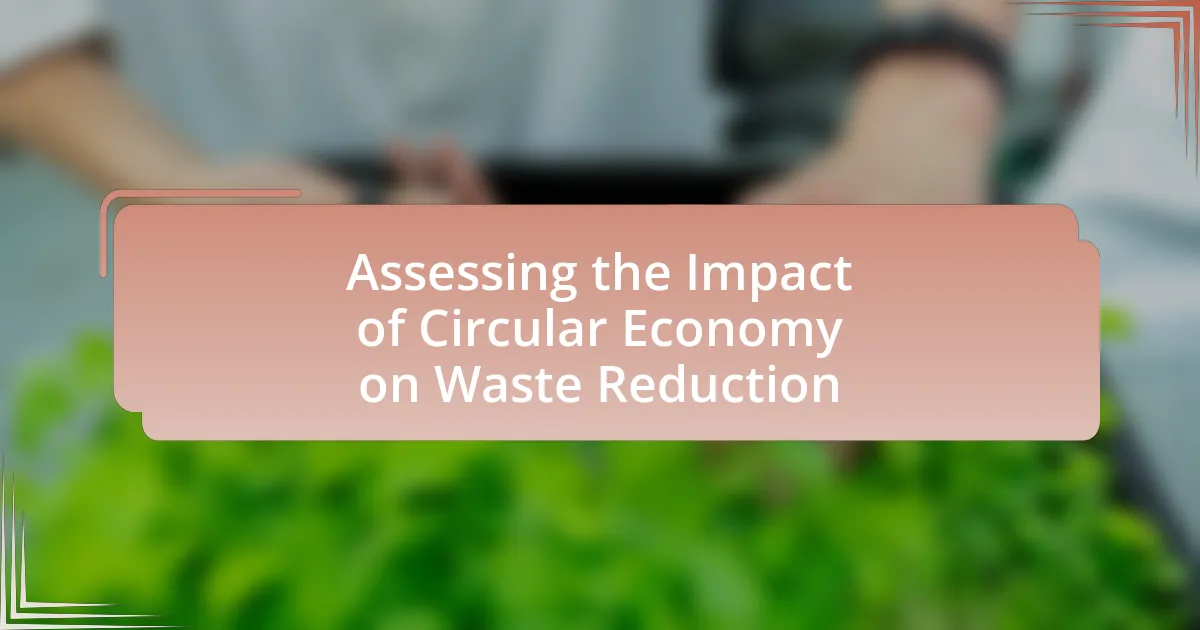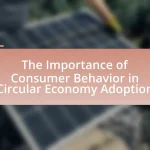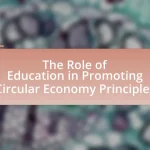The Circular Economy is an economic model focused on minimizing waste and maximizing resource efficiency through closed-loop systems that prioritize reuse, refurbishment, and recycling. This article assesses the impact of the Circular Economy on waste reduction, highlighting its differences from the traditional linear economy, key principles, and measurable outcomes. It discusses the importance of waste reduction in mitigating environmental degradation, the economic benefits of adopting circular practices, and the challenges faced in implementing these strategies. Additionally, it explores the role of technology, consumer behavior, and best practices for businesses and individuals in supporting the transition towards a more sustainable and resource-efficient economy.
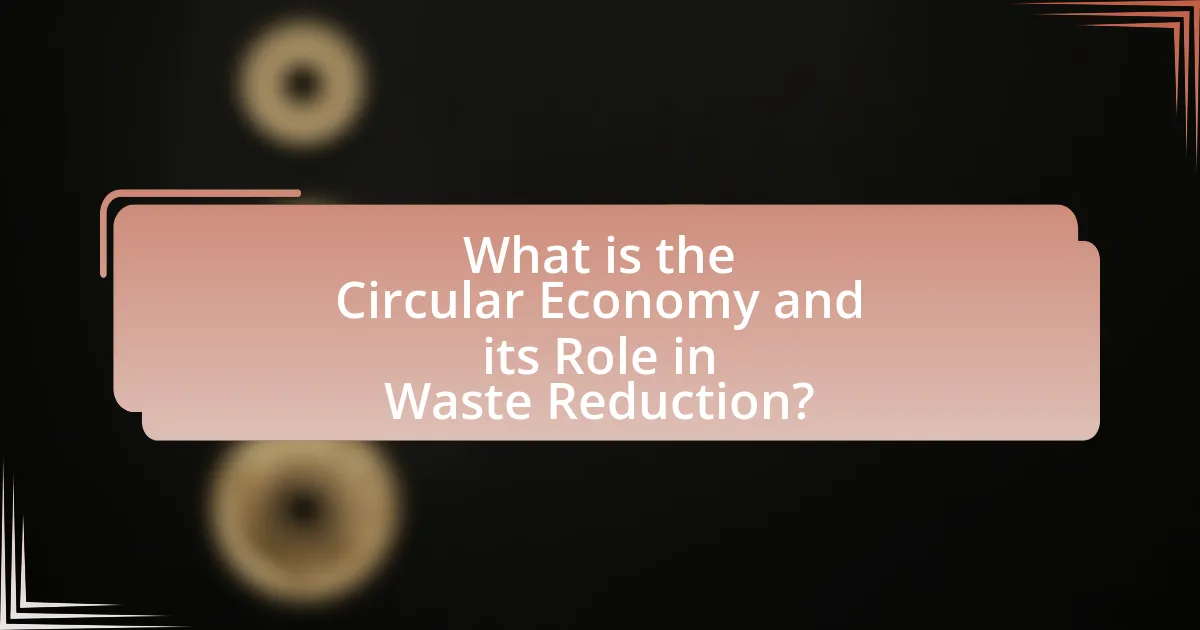
What is the Circular Economy and its Role in Waste Reduction?
The Circular Economy is an economic model that emphasizes the continual use of resources by creating closed-loop systems where waste is minimized, and materials are reused, refurbished, or recycled. This approach significantly contributes to waste reduction by transforming the traditional linear economy, which follows a ‘take-make-dispose’ pattern, into a sustainable framework that prioritizes resource efficiency and longevity. According to the Ellen MacArthur Foundation, implementing circular economy principles could reduce global waste by 22% by 2030, highlighting its potential to mitigate environmental impacts and promote sustainability.
How does the Circular Economy differ from the Traditional Linear Economy?
The Circular Economy differs from the Traditional Linear Economy in that it emphasizes resource reuse and recycling, whereas the Linear Economy follows a ‘take, make, dispose’ model. In the Circular Economy, products are designed for longevity, repairability, and recyclability, which reduces waste and conserves resources. For instance, according to the Ellen MacArthur Foundation, transitioning to a Circular Economy could reduce global greenhouse gas emissions by 39% by 2030, highlighting its potential for significant waste reduction compared to the Linear model, which typically results in increased waste and resource depletion.
What are the key principles of the Circular Economy?
The key principles of the Circular Economy include designing for longevity, maintaining product value, and minimizing waste. These principles emphasize creating products that are durable and can be easily repaired, reused, or recycled, thereby extending their lifecycle. For instance, the Ellen MacArthur Foundation highlights that a circular economy aims to keep resources in use for as long as possible, reducing the need for new materials and minimizing environmental impact. This approach not only conserves resources but also significantly reduces waste, aligning with sustainability goals.
How does the Circular Economy contribute to sustainability?
The Circular Economy contributes to sustainability by promoting resource efficiency and minimizing waste through the continual use of materials. This model reduces the extraction of finite resources, thereby lowering environmental degradation and carbon emissions. For instance, a study by the Ellen MacArthur Foundation highlights that transitioning to a Circular Economy could reduce global greenhouse gas emissions by 39% by 2030. By designing products for longevity, repairability, and recyclability, the Circular Economy fosters a sustainable approach that not only conserves resources but also supports economic growth through new business models and job creation in recycling and remanufacturing sectors.
Why is Waste Reduction Important in Today’s Context?
Waste reduction is crucial in today’s context due to its significant role in mitigating environmental degradation and conserving resources. The increasing global population and consumption patterns have led to a dramatic rise in waste generation, with the World Bank estimating that global waste will increase by 70% by 2050 if no action is taken. This surge in waste contributes to pollution, greenhouse gas emissions, and the depletion of natural resources, making waste reduction essential for sustainable development. Furthermore, implementing waste reduction strategies can lead to economic benefits, such as cost savings for businesses and reduced expenses for waste management systems.
What are the environmental impacts of waste accumulation?
Waste accumulation leads to significant environmental impacts, including soil contamination, water pollution, and greenhouse gas emissions. When waste is improperly disposed of, hazardous materials can leach into the soil, affecting local ecosystems and potentially entering the food chain. For instance, the Environmental Protection Agency (EPA) reports that landfills are a major source of methane, a potent greenhouse gas that contributes to climate change. Additionally, waste accumulation can lead to the pollution of waterways, harming aquatic life and disrupting ecosystems. According to a study published in the journal “Waste Management,” improper waste management practices can result in the release of toxic substances into water bodies, further exacerbating environmental degradation.
How does waste reduction benefit the economy?
Waste reduction benefits the economy by lowering costs associated with waste management and resource consumption. When businesses minimize waste, they reduce expenses related to disposal, transportation, and processing of waste materials. For instance, a study by the Ellen MacArthur Foundation found that transitioning to a circular economy could generate $1 trillion in economic benefits by 2025 through improved resource efficiency and reduced waste. Additionally, waste reduction fosters innovation and creates new job opportunities in recycling and sustainable product design, further stimulating economic growth.
What are the main strategies employed in the Circular Economy for Waste Reduction?
The main strategies employed in the Circular Economy for waste reduction include designing for longevity, promoting reuse and repair, implementing recycling systems, and utilizing waste as a resource. Designing for longevity ensures products are created to last longer, reducing the frequency of disposal. Promoting reuse and repair encourages consumers to extend the life of products rather than discarding them. Implementing recycling systems facilitates the recovery of materials from waste, allowing them to be reintroduced into the production cycle. Utilizing waste as a resource transforms what would be considered waste into valuable inputs for new products, thereby minimizing overall waste generation. These strategies collectively contribute to a significant reduction in waste, as evidenced by studies showing that circular economy practices can reduce waste by up to 70% in certain sectors.
How does recycling fit into the Circular Economy model?
Recycling is a fundamental component of the Circular Economy model as it facilitates the continuous reuse of materials, thereby minimizing waste. In this model, products are designed for longevity, repairability, and recyclability, which allows materials to re-enter the production cycle rather than being discarded. According to the Ellen MacArthur Foundation, effective recycling can significantly reduce the demand for virgin resources, leading to a decrease in environmental impact and resource depletion. This integration of recycling into the Circular Economy not only promotes sustainability but also enhances economic efficiency by creating a closed-loop system where materials are perpetually cycled back into use.
What role does product design play in waste reduction?
Product design plays a crucial role in waste reduction by enabling the creation of products that are more durable, recyclable, and resource-efficient. Effective product design incorporates principles of the circular economy, which emphasizes minimizing waste through sustainable materials and design for disassembly. For instance, products designed for easy repair and recycling can significantly reduce landfill contributions; a study by the Ellen MacArthur Foundation found that improving product design could lead to a 70% reduction in waste generated from consumer goods. This demonstrates that thoughtful product design not only enhances functionality but also directly contributes to waste reduction efforts.

What are the measurable impacts of the Circular Economy on Waste Reduction?
The measurable impacts of the Circular Economy on waste reduction include a significant decrease in landfill waste and an increase in recycling rates. For instance, a study by the Ellen MacArthur Foundation indicates that implementing circular economy principles could reduce global waste by 22% by 2030. Additionally, the European Commission reported that circular economy initiatives could lead to a 50% increase in recycling rates across member states, thereby minimizing the volume of waste sent to landfills. These statistics demonstrate the effectiveness of circular economy strategies in achieving substantial waste reduction.
How can we assess the effectiveness of Circular Economy initiatives?
To assess the effectiveness of Circular Economy initiatives, one can evaluate key performance indicators (KPIs) such as waste reduction rates, resource recovery rates, and lifecycle assessments. These metrics provide quantifiable data on how well initiatives minimize waste and enhance resource efficiency. For instance, a study by the Ellen MacArthur Foundation found that implementing Circular Economy principles could reduce global greenhouse gas emissions by 39% by 2030, demonstrating significant potential for waste reduction. Additionally, tracking the economic benefits, such as cost savings from reduced material use and increased revenue from recycled materials, further validates the effectiveness of these initiatives.
What metrics are used to evaluate waste reduction outcomes?
Metrics used to evaluate waste reduction outcomes include waste diversion rates, landfill diversion rates, and recycling rates. Waste diversion rates measure the percentage of waste materials diverted from landfills through recycling, composting, or reuse. Landfill diversion rates specifically focus on the proportion of waste that is not sent to landfills, indicating the effectiveness of waste management strategies. Recycling rates quantify the amount of material recycled compared to the total waste generated, providing insight into the efficiency of recycling programs. These metrics are essential for assessing the impact of circular economy initiatives on reducing waste and promoting sustainable practices.
How do case studies illustrate the impact of Circular Economy practices?
Case studies illustrate the impact of Circular Economy practices by providing real-world examples of how businesses and communities have successfully implemented these strategies to reduce waste and enhance resource efficiency. For instance, the case study of Interface, a global carpet tile manufacturer, demonstrates how the company adopted a closed-loop system, resulting in a 96% reduction in waste sent to landfills and a significant decrease in raw material usage through recycling initiatives. Additionally, the Ellen MacArthur Foundation’s case studies highlight various companies that have transitioned to circular models, showing that adopting such practices can lead to increased profitability and sustainability. These examples validate the effectiveness of Circular Economy practices in achieving substantial waste reduction and promoting sustainable development.
What challenges does the Circular Economy face in achieving waste reduction?
The Circular Economy faces significant challenges in achieving waste reduction, primarily due to systemic barriers, consumer behavior, and technological limitations. Systemic barriers include the lack of supportive policies and regulations that incentivize sustainable practices, which can hinder the transition from linear to circular models. Consumer behavior poses another challenge, as many individuals remain resistant to changing their consumption habits and may prioritize convenience over sustainability. Additionally, technological limitations, such as insufficient recycling infrastructure and the need for advanced materials processing, restrict the effectiveness of circular initiatives. According to a report by the Ellen MacArthur Foundation, only 9% of plastic is recycled globally, highlighting the urgent need for improved systems to facilitate waste reduction within the Circular Economy framework.
What are the barriers to implementing Circular Economy practices?
The barriers to implementing Circular Economy practices include lack of awareness, insufficient infrastructure, and economic constraints. Lack of awareness among businesses and consumers hinders the adoption of sustainable practices, as many do not understand the benefits of a Circular Economy. Insufficient infrastructure, such as recycling facilities and logistics systems, limits the ability to effectively manage materials in a circular manner. Economic constraints, including high initial investment costs and the perception of lower profitability, deter companies from transitioning to Circular Economy models. According to a report by the Ellen MacArthur Foundation, these barriers significantly impede the shift towards sustainable practices, highlighting the need for targeted interventions to overcome them.
How can businesses overcome these challenges?
Businesses can overcome challenges in implementing a circular economy by adopting innovative practices such as redesigning products for longevity, utilizing sustainable materials, and establishing take-back programs. For instance, companies like Patagonia have successfully integrated product repair and recycling initiatives, which not only reduce waste but also enhance brand loyalty. Additionally, collaboration with stakeholders, including suppliers and customers, fosters a shared commitment to sustainability, as evidenced by the Ellen MacArthur Foundation’s research highlighting that circular practices can lead to significant cost savings and resource efficiency. By leveraging technology for better resource management and engaging in continuous education about circular economy principles, businesses can effectively navigate and mitigate the challenges associated with waste reduction.
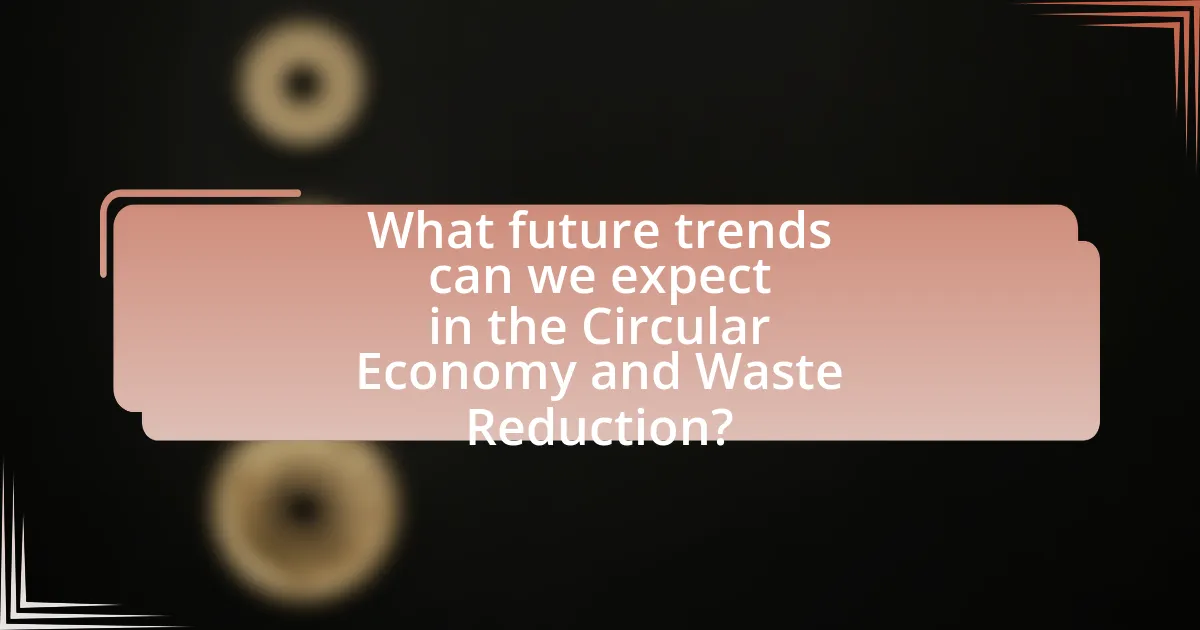
What future trends can we expect in the Circular Economy and Waste Reduction?
Future trends in the Circular Economy and Waste Reduction include increased adoption of sustainable materials, enhanced recycling technologies, and a shift towards product-as-a-service models. The use of biodegradable and renewable materials is expected to rise, driven by consumer demand for environmentally friendly products and regulatory pressures. Advanced recycling technologies, such as chemical recycling, will improve the efficiency of material recovery, allowing for higher quality recycled materials. Additionally, businesses are increasingly adopting product-as-a-service models, which promote the sharing and leasing of products instead of ownership, thereby reducing waste. According to a report by the Ellen MacArthur Foundation, transitioning to a circular economy could generate $4.5 trillion in economic benefits by 2030, highlighting the significant potential for waste reduction and resource efficiency.
How is technology shaping the future of the Circular Economy?
Technology is shaping the future of the Circular Economy by enabling efficient resource management and waste reduction through innovations such as IoT, AI, and blockchain. These technologies facilitate real-time tracking of materials, optimize supply chains, and enhance recycling processes. For instance, IoT devices can monitor product usage and end-of-life stages, allowing companies to reclaim materials effectively. AI algorithms analyze data to improve recycling rates and identify new opportunities for reusing materials. Additionally, blockchain technology ensures transparency in supply chains, making it easier to verify the sustainability of materials. According to a report by the Ellen MacArthur Foundation, implementing digital technologies in the Circular Economy could generate $4.5 trillion in economic benefits by 2030, highlighting the significant impact of technology on waste reduction and resource efficiency.
What innovations are emerging in waste management and recycling?
Innovations in waste management and recycling include advanced sorting technologies, such as artificial intelligence and machine learning, which enhance the efficiency of material recovery facilities. These technologies enable precise identification and separation of recyclables, significantly increasing recycling rates. For instance, AI-driven robots can sort through waste at speeds exceeding 60 items per minute, improving operational efficiency and reducing contamination in recycling streams. Additionally, the development of biodegradable materials and chemical recycling processes allows for the conversion of plastics back into their original monomers, facilitating a closed-loop system. Research indicates that implementing these innovations can lead to a reduction in landfill waste by up to 50%, demonstrating their potential impact on promoting a circular economy.
How can digital platforms enhance Circular Economy practices?
Digital platforms can enhance Circular Economy practices by facilitating resource sharing, improving product lifecycle management, and enabling data-driven decision-making. These platforms allow users to connect for sharing goods and services, which reduces the need for new products and minimizes waste. For instance, platforms like Airbnb and Uber exemplify resource sharing by optimizing the use of existing assets. Additionally, digital platforms can track product usage and end-of-life options, helping businesses design for longevity and recyclability. Research indicates that companies utilizing digital tools for lifecycle management can reduce waste by up to 30%, demonstrating the effectiveness of these platforms in promoting sustainable practices.
What role do consumers play in the Circular Economy?
Consumers play a crucial role in the Circular Economy by driving demand for sustainable products and practices. Their purchasing decisions influence manufacturers to adopt eco-friendly materials and processes, thereby reducing waste. For instance, a study by the Ellen MacArthur Foundation highlights that consumer preferences for circular products can lead to a significant reduction in resource extraction and waste generation, as companies respond to this demand by designing products for longevity, repairability, and recyclability. This active participation not only fosters a market for sustainable goods but also encourages businesses to innovate towards more circular practices, ultimately contributing to waste reduction.
How can consumer behavior influence waste reduction efforts?
Consumer behavior significantly influences waste reduction efforts by determining purchasing patterns and product usage. When consumers prioritize sustainable products, they drive demand for eco-friendly alternatives, prompting companies to adopt greener practices. For instance, a study by the Nielsen Global Sustainability Report found that 66% of consumers are willing to pay more for sustainable brands, indicating that consumer preferences can lead to reduced waste through increased demand for products with minimal packaging and longer lifespans. Additionally, behaviors such as recycling, composting, and reducing single-use items directly contribute to lower waste generation, showcasing the power of consumer choices in promoting waste reduction initiatives.
What are some best practices for consumers to support the Circular Economy?
Consumers can support the Circular Economy by prioritizing sustainable purchasing, reducing waste, and engaging in recycling practices. Sustainable purchasing involves selecting products made from recycled materials or designed for longevity, which minimizes resource extraction and waste generation. Reducing waste can be achieved by opting for reusable items instead of single-use products, thereby decreasing the volume of waste sent to landfills. Engaging in recycling practices ensures that materials are processed and reintroduced into the production cycle, further supporting the Circular Economy. According to the Ellen MacArthur Foundation, transitioning to a Circular Economy could reduce global waste by 70% by 2030, highlighting the significant impact consumer choices can have on waste reduction.
What practical steps can businesses take to implement Circular Economy principles?
Businesses can implement Circular Economy principles by adopting strategies such as designing products for longevity, utilizing sustainable materials, and establishing take-back programs. Designing for longevity involves creating products that are durable and easy to repair, which reduces waste and encourages reuse. Utilizing sustainable materials, such as recycled or biodegradable inputs, minimizes resource extraction and environmental impact. Establishing take-back programs allows businesses to reclaim products at the end of their life cycle, facilitating recycling and reducing landfill contributions. These steps are supported by research indicating that companies adopting Circular Economy practices can significantly reduce waste and improve resource efficiency, as evidenced by a report from the Ellen MacArthur Foundation, which highlights that transitioning to a circular model could generate $4.5 trillion in economic benefits by 2030.
